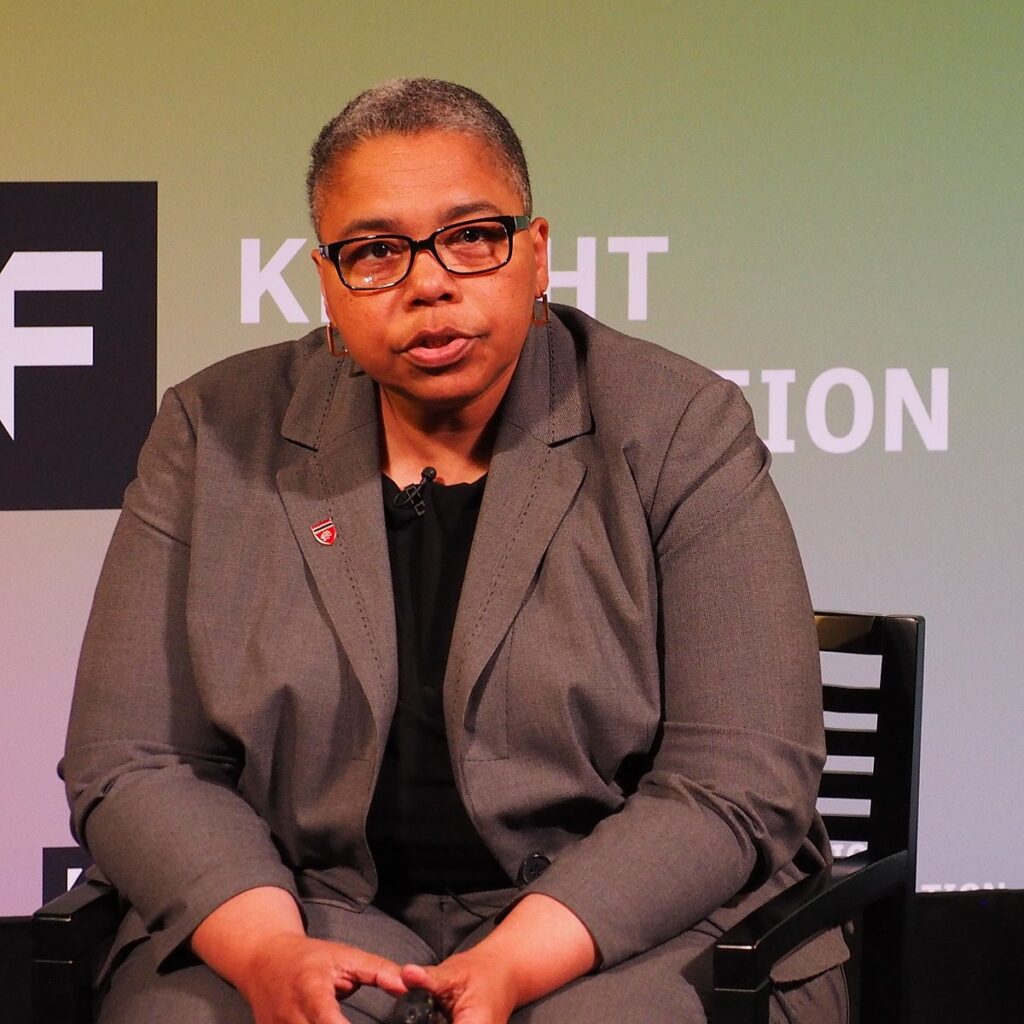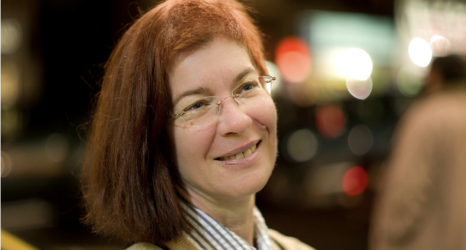Advice to Her Younger Self features female leaders who are harnessing the power of technology to drive change—and want to help the next generation do the same. These experts are using tech to build better communities and a better world as active members of the new field called Public Interest Technology, and they’re opening up to us about what they’ve learned along the way. This series is produced in partnership with the Ford Foundation.
One day, when she was enrolled in MIT’s graduate computer science program, Latanya Sweeney came upon a kind of Cassandra who told of a grim future where computers and tech rule our lives.
“Computers are evil,” said this oracle (aka Beverly Woodward, a professor from Brandeis University). Technology will victimize people, she predicted. Their private medical information, for example, will be hacked and used for nefarious purposes like blackmail. Such an unconscionable misdeed, she said, was taking place right then in 1997 in Massachusetts.
Sweeney was dubious. She had strong faith in computers. She believed that medical data are secure, and maintained that individuals whose information is collected are unidentifiable, as they should be. Sweeney was confident in the impossibility of connecting points of data to re-identify subjects in order to discover who has a heart condition or a drug problem or cancer in the family. Using publicly-accessible demographic information, she set out to prove Woodward wrong.

“That simple experiment ended up doing the opposite, showing that data could be re-identified,” she says. “The next day I was testifying before Congress.”
Now a professor of government and technology at Harvard University, Sweeney says that single experiment changed the course of her career. Rather than designing computers, as she’d always wanted, she became invested in examining the unforeseen consequences of technological innovation.
Consider the Sony Camcorder, which came to market in 1984. It recorded both video and sound simultaneously—and it lacked a mute button, a fact few noticed or seemed to care about at the time.
“Our laws in the United States were really clear,” Sweeney explains. “It’s okay to photograph people in public, and you needed consent in order to record conversations. Here was this device that was going to record both video and sound without a mute button. Legal issues came up right away.”
A Pennsylvania woman was arrested for illegal wiretapping after she strapped the device to her child’s body so she would have proof about school-bus bullying. A bystander in Boston was similarly charged when his Camcorder caught audio tape, in addition to video, of police arresting a protestor.
“The ACLU fought that case and won us the right to basically record the police in the service of their duties,” Sweeney recalls. “Nowadays, Pennsylvania has a law that requires cameras in all of its school buses. There was no laws or debates about it… When technology is financially successful like it was in the case of Camcorder, the design gets replicated. Even today if you pull out a smartphone and you go to record a video, it doesn’t have a mute button either.”
We live in an age, Sweeney says, in which “every democratic value is basically up for grabs by what technology design allows or doesn’t allow.” It’s this intersection that compels her. Yet it wasn’t always.
“All my life I wanted to be a computer scientist,” Sweeney says, recounting an unusual dream for a girl growing up in the 60s and 70s, when home computers were rare, and technology’s ubiquity was the stuff of science fiction. “I wanted to build a thinking machine.”
Raised by great-grandparents in Nashville, Sweeney left Tennessee for an all-girls Massachusetts boarding school when her great-grandparents passed away. She excelled at math and for college, she headed to MIT, where she “was usually the only Black or the only female in my classes,” a kind of unicorn whom professors, accustomed to students who resembled themselves, didn’t quite know how to or find interest in mentoring.
At MIT, she found a foreign culture. “I was really unprepared for such a male bastion, as well as an almost religious belief in science,” she says. “It was a really difficult turf for me to navigate. There was no real support. People who wanted to support me didn’t know how. I didn’t even know how to support myself either. It was very difficult, very confusing, very frustrating.”
At that same time, “computer science was really new,” she says. “I don’t think I had a single professor who had a degree in computer science. They either had a degree in math or in engineering. It didn’t take long, that many hours, inside of a computer lab before you knew about as much as your professors.”
This was in the 1980s. Her encounter with the oracle was still a decade or so away. And when Sweeney saw peers around her ditch the confines of the academy for the wild west of a brand new industry, she followed suit—founding a company which she ran for a decade. It was an adventure, she says, a very exciting time to be a young pioneer in tech and vastly preferable to her uneasy experience at college. But there were drawbacks.
“I never became Gates,” she says, pointing out that in those early days of tech, there was no adequate way to amplify her achievements. “I had no voice about the technology I was building. I would do something that was really quite noteworthy, but there was nowhere to publish about it. You could get paid for it, but there was no way to say, ‘You won’t believe what I just did!’ The only way to get it was to go back to school.”
So she did, transferring to Harvard for her bachelor’s degree before returning to MIT. There, she won the distinction of being the institution’s first African-American woman to earn a PhD in computer science. Along the way, she got “really good at turning lemons into lemonade.”
Sweeney tells would-be computer scientists now to do the same. “I stopped caring about why someone wasn’t doing right by me, or giving me the same opportunities or whatever, or just treating me unfairly.”
She also advises them to assemble themselves a committee of mentors, rather than pinpoint a single individual who may be short of time or interest to guide them. And she recommends that students, particularly women and people of color, focus their work in new areas of technology, since established fields are often overseen by older academics—often white men—who may adhere to a mentoring system where they favor mentees who look like them. For her part, she always keeps her door open, knowing that students, particularly ones who look like her, face the kinds of challenges she encountered.
Ever a booster of Public Interest Technology, Sweeney says it has the ability to change the world. “If you go to a discipline that’s been well-studied, the best you can do is find out how you’re going to put a little bitty brick into this huge brick wall,” she says. By contrast, PIT is “a brand new area. It’s across disciplines. Young computer scientists, or young technologists, or young scholars from all backgrounds can find their place there.”





